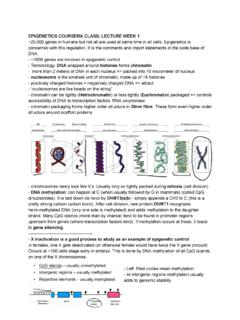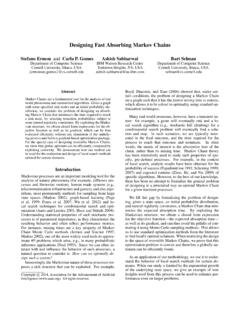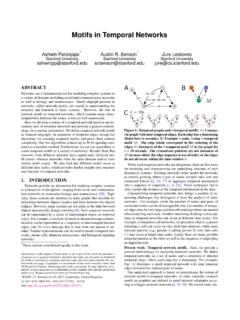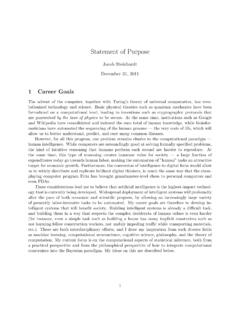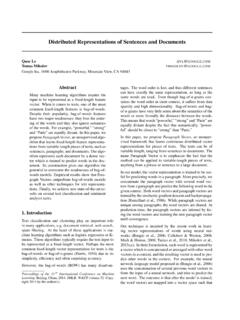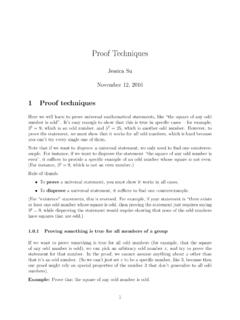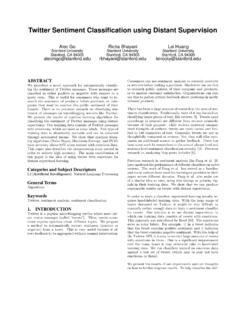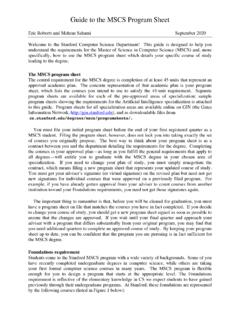Transcription of Deep Visual-Semantic Alignments for Generating Image ...
1 Deep Visual-Semantic Alignments for Generating Image Descriptions Andrej Karpathy Li Fei-Fei Department of Computer Science, Stanford University Abstract We present a model that generates natural language de- scriptions of images and their regions. Our approach lever- ages datasets of images and their sentence descriptions to learn about the inter-modal correspondences between lan- guage and visual data. Our alignment model is based on a novel combination of Convolutional Neural Networks over Image regions, bidirectional Recurrent Neural Networks over sentences, and a structured objective that aligns the two modalities through a multimodal embedding.
2 We then describe a Multimodal Recurrent Neural Network architec- ture that uses the inferred Alignments to learn to generate novel descriptions of Image regions. We demonstrate that our alignment model produces state of the art results in re- trieval experiments on Flickr8K, Flickr30K and MSCOCO. datasets. We then show that the generated descriptions sig- Figure 1. Motivation/Concept Figure: Our model treats language nificantly outperform retrieval baselines on both full images as a rich label space and generates descriptions of Image regions.
3 And on a new dataset of region-level annotations. Generating dense descriptions of images (Figure 1). The 1. Introduction primary challenge towards this goal is in the design of a model that is rich enough to simultaneously reason about A quick glance at an Image is sufficient for a human to contents of images and their representation in the domain point out and describe an immense amount of details about of natural language. Additionally, the model should be free the visual scene [14]. However, this remarkable ability has of assumptions about specific hard-coded templates, rules proven to be an elusive task for our visual recognition mod- or categories and instead rely on learning from the training els.
4 The majority of previous work in visual recognition data. The second, practical challenge is that datasets of im- has focused on labeling images with a fixed set of visual age captions are available in large quantities on the internet categories and great progress has been achieved in these en- [21, 58, 37], but these descriptions multiplex mentions of deavors [45, 11]. However, while closed vocabularies of vi- several entities whose locations in the images are unknown. sual concepts constitute a convenient modeling assumption, they are vastly restrictive when compared to the enormous Our core insight is that we can leverage these large Image - amount of rich descriptions that a human can compose.
5 Sentence datasets by treating the sentences as weak labels, Some pioneering approaches that address the challenge of in which contiguous segments of words correspond to some Generating Image descriptions have been developed [29, particular, but unknown location in the Image . Our ap- 13]. However, these models often rely on hard-coded visual proach is to infer these Alignments and use them to learn concepts and sentence templates, which imposes limits on a generative model of descriptions. Concretely, our contri- their variety.
6 Moreover, the focus of these works has been butions are twofold: on reducing complex visual scenes into a single sentence, We develop a deep neural network model that in- which we consider to be an unnecessary restriction. fers the latent alignment between segments of sen- In this work, we strive to take a step towards the goal of tences and the region of the Image that they describe. Our model associates the two modalities through a sual domain [27, 39, 60, 36]. Our approach is inspired by common, multimodal embedding space and a struc- Frome et al.
7 [16] who associate words and images through tured objective. We validate the effectiveness of this a semantic embedding. More closely related is the work of approach on Image -sentence retrieval experiments in Karpathy et al. [24], who decompose images and sentences which we surpass the state-of-the-art. into fragments and infer their inter-modal alignment using a ranking objective. In contrast to their model which is based We introduce a multimodal Recurrent Neural Network on grounding dependency tree relations, our model aligns architecture that takes an input Image and generates contiguous segments of sentences which are more mean- its description in text.
8 Our experiments show that the ingful, interpretable, and not fixed in length. generated sentences significantly outperform retrieval- based baselines, and produce sensible qualitative pre- Neural networks in visual and language domains. Mul- dictions. We then train the model on the inferred cor- tiple approaches have been developed for representing im- respondences and evaluate its performance on a new ages and words in higher-level representations. On the im- dataset of region-level annotations. age side, Convolutional Neural Networks (CNNs) [32, 28].
9 1 have recently emerged as a powerful class of models for We make code, data and annotations publicly available. Image classification and object detection [45]. On the sen- 2. Related Work tence side, our work takes advantage of pretrained word vectors [41, 22, 3] to obtain low-dimensional representa- Dense Image annotations. Our work shares the high-level tions of words. Finally, Recurrent Neural Networks have goal of densely annotating the contents of images with been previously used in language modeling [40, 50], but we many works before us.
10 Barnard et al. [2] and Socher et additionally condition these models on images. al. [48] studied the multimodal correspondence between words and images to annotate segments of images. Sev- 3. Our Model eral works [34, 18, 15, 33] studied the problem of holistic Overview. The ultimate goal of our model is to generate scene understanding in which the scene type, objects and descriptions of Image regions. During training, the input their spatial support in the Image is inferred. However, the to our model is a set of images and their corresponding focus of these works is on correctly labeling scenes, objects sentence descriptions (Figure 2).
